Comprehensive Evaluation of the Importance of Ecological Land in Arid Hilly Cities in Northwest China: A Case Study of the Core Urban Area of Lanzhou
Abstract
:1. Introduction
2. Materials and Methods
2.1. Overview of the Study Area and Data Sources
2.2. Methodology Framework
2.3. Ecological Function Importance Assessment
2.3.1. Biodiversity Maintenance Function
2.3.2. Soil Conservation Function
2.3.3. Water Conservation Function
2.4. Assessment of Ecological Demand
3. Results and Discussion
3.1. Impact of Ecological Service Function and the Intensity of Ecological Demand on the Importance of Ecological Land
3.2. Analysis of the Overall Characteristics of Ecological Land Structure
3.3. Analysis of Ecological Land Structure Characteristics at the Land Use Level
3.4. Analysis of the Structural Characteristics of Ecological Land at the Level of Spatial Distribution
3.5. Significance and Application
3.6. Limitations
4. Conclusions
- (1)
- The model used to evaluate the importance of ecological land was based on the dual perspectives of the function of providing ecosystem services and the intensity of ecological demand. This model is more suitable to evaluate for the need for ecological protection in arid and hilly areas of northwest China and highly urbanized areas. Compared with only considering the ecosystem service function of ecological land, the research results can consider the demands and needs of urban residents and can effectively identify the types of ecological land that have a high degree of ecological demand within the city, which has practical significance for the protection of ecological resources in the core of the city.
- (2)
- For the core urban area of Lanzhou, even from a single perspective of ecological function, urban parks and public green space in densely populated areas of urbanized area also have very important ecological values. After adding an evaluation of the intensity of ecological demand, the ecological importance of parks and other green space in urbanized area was further strengthened. Most of the most important ecological land was distributed in densely populated areas. Obviously, for cities in the arid and hilly areas of northwest China represented by the core urban area of Lanzhou, the spread of urbanized areas will not mean that the surrounding natural landscape will inevitably be destroyed. On the contrary, the development of cities may provide opportunities for the ecological restoration and renovation of surrounding barren and bare land.
- (3)
- The most important and very important ecological land in the core area of Lanzhou only accounted for 5.86% of the total area of all ecological land within the city, indicating that high-value ecological land in the core area of Lanzhou is still very scarce. Among these important areas, the water area (mainly the Yellow River and its waterfront space) is the ecological land with the highest average ecological value in Lanzhou, followed by forest land. In addition, one can see that the land type with the highest spatial proportion among all levels of ecological land is grassland. Grassland can be said to be the ecological land with the most potential in the core urban area of Lanzhou; its ecological function will be continuously lost over time if it is not properly managed and protected. Careful planning and use can allow grassland to serve as an indispensable ecological barrier in Lanzhou, which can not only play an ecological function but can also provide good aesthetic space and recreational opportunities for the general public.
- (4)
- From the perspective of spatial distribution, the urbanized areas of Chengguan and Anning districts accounted for a large proportion; these areas have a limited amount of ecological land, but the most important ecological land is also mostly distributed here. Qilihe and Xigu districts have more generally important graded areas of forest, grassland, and bare land, although the current ecological value of these lands is limited; nevertheless, these lands have great potential for ecological improvement, which should be considered in the future. With the accelerating development of Lanzhou in recent years, a large number of underused ecological lands in Qilihe and Xigu undoubtedly include valuable properties in the core urban area of Lanzhou. These areas will need to be continuously improved to reach their peak ecological service capacity in light of urban sprawl and urban function transfer. Appropriate land management should be carried out to further improve the level of connectivity through the construction of ecological corridors, so as to form a scientific and reasonable regional ecological security pattern and lay a healthy and sustainable material foundation for a new round of urban development.
Author Contributions
Funding
Institutional Review Board Statement
Informed Consent Statement
Data Availability Statement
Acknowledgments
Conflicts of Interest
References
- Liu, Y.Q.; Wang, R.Y.; Lu, Y.; Li, Z.G.; Chen, H.S.; Cao, M.Q.; Zhang, Y.R.; Song, Y.M. Natural outdoor environment, neighbourhood social cohesion and mental health: Using multilevel structural equation modelling, streetscape and remote-sensing metrics. Urban For. Urban Green. 2020, 48, 126576. [Google Scholar] [CrossRef]
- Yu, F.; Li, X.B.; Zhang, L.J.; Xu, W.H.; Fu, R.; Wang, H. Study of ecological land in China: Conception, classification, and spatial-temporal pattern. Acta Ecol. Sin. 2015, 35, 4931–4943. [Google Scholar]
- Aminzadeh, B.; Khansefid, M. A case study of urban ecological networks and a sustainable city: Tehran’s metropolitan area. Urban Ecosyst. 2010, 13, 23–36. [Google Scholar] [CrossRef]
- Vergnes, A.; Kerbiriou, C.; Clergeau, P. Ecological corridors also operate in an urban matrix: A test case with garden shrews. Urban Ecosyst. 2013, 16, 511–525. [Google Scholar] [CrossRef]
- Xie, H.; Yao, G.; Liu, G. Spatial evaluation of the ecological importance based on GIS for environmental management: A case study in Xingguo county of China. Ecol. Indic. 2015, 51, 3–12. [Google Scholar] [CrossRef]
- Peng, J.; Zong, M.L.; Hu, Y.N.; Liu, Y.X.; Wu, J.S. Assessing landscape ecological risk in a mining city: A case study in Liaoyuan city, China. Sustainability 2015, 7, 8312–8334. [Google Scholar] [CrossRef] [Green Version]
- Wu, J.S.; Zhang, L.Q.; Peng, J.; Feng, Z.; Liu, H.M.; He, S.B. The integrated recognition of the source area of the urban ecological security pattern in Shenzhen. Acta Ecol. Sin. 2013, 33, 4125–4133. [Google Scholar]
- Peng, J.; Wang, A.; Liu, Z.X.; Ma, J.; Wu, J.S. Research progress and prospect on measuring urban ecological land demand. Acta Georaphica Sin. 2015, 70, 333–346. [Google Scholar]
- Zhou, Z.; Meng, J.J.; Qi, Y.; Peng, F.L. Importance of ecological lands and their pattern optimization in China: A review. Chin. J. Ecol. 2016, 35, 218–225. [Google Scholar]
- Orban, E.; Sutcliffe, R.; Dragano, N.; Jöckel, K.H.; Moebus, S. Residential surrounding greenness, self-rated health and interrelations with aspects of neighborhood environment and social relations. J. Urban Health 2017, 94, 158–169. [Google Scholar] [CrossRef] [Green Version]
- Van Renterghem, T.; Botteldooren, D. View on outdoor vegetation reduces noise annoyance for dwellers near busy roads. Landsc. Urban Plan. 2016, 148, 203–215. [Google Scholar] [CrossRef] [Green Version]
- Enssle, F.; Kabisch, N. Urban green spaces for the social interaction, health and well-being of older people: An integrated view of urban ecosystem services and socio-environmental justice. Environ. Sci. Policy 2020, 109, 36–44. [Google Scholar] [CrossRef]
- Baró, F.; Palomo, I.; Zulian, G.; Vizcaino, P.; Haase, D.; Gómez-Baggethun, E. Mapping ecosystem service capacity, flow and demand for landscape and urban planning: A case study in the Barcelona metropolitan region. Land Use Policy 2016, 57, 405–417. [Google Scholar] [CrossRef] [Green Version]
- Wolff, S.; Schulp, C.J.E.; Verburg, P.H. Mapping ecosystem services demand: A review of current research and future perspectives. Ecol. Indic. 2015, 55, 159–171. [Google Scholar] [CrossRef]
- Zhang, Y.N.; Chen, Z.J.; Zhang, Y.Q.; Mei, M.Y. Urban ecological importance assessment based on ecological function and ecological demand: A case study of Changsha. Resour. Environ. Yangtze Basin 2018, 27, 2358–2367. [Google Scholar]
- Zhang, L.Q.; Peng, J.; Liu, Y.X.; Wu, J.S. Coupling ecosystem services supply and human ecological demand to identify landscape ecological security pattern: A case study in Beijing-Tianjin-Hebei region, China. Urban Ecosyst. 2017, 20, 701–714. [Google Scholar] [CrossRef]
- Zhang, X.C.; Liang, X.C.; Song, X.; Liu, J.S. Spatial pattern of the mismatch degrees of the high-quality development of tourism industry in the Yellow River basin. J. Arid Land Resour. Environ. 2020, 34, 201–208. [Google Scholar]
- Wang, S.P.; Qiao, H.F.; Feng, J.; Xie, S.Y. The spatio-temporal evolution of tourism eco-efficiency in the Yellow River basin and its interactive response with tourism economy development level. Econ. Geogr. 2020, 40, 81–89. [Google Scholar]
- Ma, L. Debate and thinking about the ecological impact of “bulldoze mountains to build new city”: A case study of Lanzhou new city. Mod. Urban Res. 2016, 6, 85–90. [Google Scholar]
- Gao, J.X.; Xu, D.L.; Qiao, Q.; Zou, C.X.; Wang, Y.; Tian, M.R.; Wang, Y. Pattern construction of natural ecological space and planning theory exploration. Acta Ecol. Sin. 2020, 40, 749–755. [Google Scholar]
- Gozdowski, D.; Stępién, M.; Panek, E.; Varghese, J.; Bodecka, E.; Rozbicki, J.; Samborski, S. Comparison of winter wheat NDVI data derived from Landsat 8 and active optical sensor at field scale. Remote Sens. Appl. 2020, 20, 100409. [Google Scholar] [CrossRef]
- Cao, H.Y.; Han, L.; Liu, Z.H.; Li, L.Z. Monitoring and driving force analysis of spatial and temporal change of water area of Hongjiannao Lake from 1973 to 2019. Ecol. Inform. 2021, 61, 101230. [Google Scholar] [CrossRef]
- Song, N.Y.; Wei, L. Study on urban greening in Lanzhou from 1941 to 1949. J. Arid Land Resour. Environ. 2019, 33, 184–189. [Google Scholar]
- Ma, C.; Li, S.; Liu, J.; Gao, Y.; Wang, Y. Regionalization of ecosystem Services of Beijing-Tianjin-Hebei Area based on SOFM neural network. Prog. Geogr. 2013, 32, 1383–1393. [Google Scholar]
- Meng, J.J.; Wang, Y.; Wang, X.D.; Zhou, Z.; Sun, N. Construction of landscape ecological security pattern in Guiyang based on mcr model. Resour. Environ. Yangtze Basin 2016, 25, 1052–1061. [Google Scholar]
- Bi, X.L.; Ge, J.P. Evaluating ecosystem service valuation in China based on the IGBP land cover datasets. J. Mt. Sci. 2004, 2, 48–53. [Google Scholar]
- Zurlini, G.; Petrosillo, I.; Aretano, R.; Castorini, I.; Zaccarelli, N. Key fundamental aspects for mapping and assessing ecosystem services: Predictability of ecosystem service providers at scales from local to global. Ann. Bot. 2014, 4, 53–63. [Google Scholar]
- Jahun, B.G.; Ibrahim, R.; Dlamini, N.S.; Musa, S.M. Review of soil erosion assessment using RUSLE model and GIS. J. Biol. Agric. Healthc. 2015, 5, 36–47. [Google Scholar]
- Van Oost, K.; Govers, G.; Desmet, P. Evaluating the effects of changes in landscape structure on soil erosion by water and tillage. Landsc. Ecol. 2000, 15, 577–589. [Google Scholar] [CrossRef]
- Liu, B.Y.; Nearing, M.A.; Risse, L.M. Slope gradient effects on soil lossfor steep slopes. Trans. ASAE 1994, 37, 1835–1840. [Google Scholar] [CrossRef]
- Wischmeier, W.H.; Smith, D.D. Predicting rainfall erosion losses: Aguide to conservation planning with the universal soil loss equation. In Agricultural Handbook No. 537; United States Department of Agriculture: Springfield, IL, USA, 1978. [Google Scholar]
- Wischmeier, W.H.; Smith, D.D. Rainfall energy and its relationship tosoil loss. Trans. Am. Geophys. Union 1958, 39, 285–291. [Google Scholar] [CrossRef]
- Hu, G.; Song, H.; Shi, X.J.; Zhang, M.L.; Liu, X.J.; Zhang, X.L. Soil erosion characteristics based on RUSLE in the Wohushan reservoir watershed. Sci. Geogr. Sin. 2018, 38, 610–617. [Google Scholar]
- Gong, S.H.; Xiao, Y.; Zheng, H.; Xiao, Y.; Ouyang, Z.Y. Spatial patterns of ecosystem water conservation in China and its impact factors analysis. Acta Ecol. Sin. 2017, 37, 2455–2462. [Google Scholar]
- Luo, X.; Yang, J.; Sun, W.; He, B.J. Suitability of human settlements in mountainous areas from the perspective of ventilation: A case study of the main urban area of Chongqing. J. Clean. Prod. 2021, 310, 127467. [Google Scholar] [CrossRef]
- Chen, S.L.; Chen, H.H.; Li, X. The ability of nighttime imagery in monitoring economic activity in different scales. Sci. Geogr. Sin. 2020, 40, 1476–1483. [Google Scholar]
- Lv, Q.; Liu, H.B. Multiscale spatio-temporal characteristics of carbon emission of energy consumption in Yellow River basin based on the nighttime light datasets. Econ. Geogr. 2020, 40, 12–21. [Google Scholar]
- Terrado, M.; Sabater, S.; Chaplin-Kramer, B.; Mandle, L.; Ziv, G.; Acuña, V. Model development for the assessment of terrestrial and aquatic habitat quality in conservation planning. Sci. Total Environ. 2015, 540, 63–70. [Google Scholar] [CrossRef] [Green Version]
- Wang, L.R.; Feng, X.L.; Chang, Q.; Liu, H.; Wang, J. Pattern construction of habitat network for urban green space based on the compound model of InVEST and MCR. Chin. Landsc. Archit. 2020, 36, 113–118. [Google Scholar]
- Han, Y.W.; Li, Y.N.; Li, F.Z. Effects of Landscape Patterns of Urban Green Spaces on “Core Habitat” Quality. Landsc. Archit. 2020, 27, 83–87. [Google Scholar]
- Fan, H.Y.; Yu, Z.W.; Yang, G.Y.; Liu, T.Y.; Hung, C.H.; Vejre, H. How to cool hot-humid (Asian) cities with urban trees? An optimal landscape size perspective. Agric. For. Meteorol. 2019, 265, 338–348. [Google Scholar] [CrossRef]
- Yang, G.Y.; Yu, Z.W.; Jørgensen, G.; Vejre, H. How can urban blue-green space be planned for climate adaption in high-latitude cities? A seasonal perspective. Sustain. Cities Soc. 2020, 53, 101932. [Google Scholar] [CrossRef]
- Yang, J.; Wang, Y.C.; Xue, B.; Li, Y.F.; Xiao, X.M.; Xia, J.H.; He, B.J. Contribution of urban ventilation to the thermal environment and urban energy demand: Different climate background perspectives. Sci. Total Environ. 2021, 795, 148791. [Google Scholar] [CrossRef]
- Sun, R.; Wang, Y.; Chen, L. A distributed model for quantifying temporal-spatial patterns of anthropogenic heat based on energy consumption. J. Clean. Prod. 2018, 170, 601–609. [Google Scholar] [CrossRef]
- Ebrahimi, A.; Motamedvaziri, B.; Nazemosadat, S.M.J.; Ahmadi, H. Investigating the land surface temperature reaction to the land cover patterns during three decades using landsat data. Int. J. Environ. Sci. Technol. 2021. [Google Scholar] [CrossRef]
- Yang, J.; Yang, R.X.; Chen, M.H.; Su, C.H.; Zhi, Y.; Xi, J.C. Effects of rural revitalization on rural tourism. J. Hosp. Tour. Manag. 2021, 47, 35–45. [Google Scholar] [CrossRef]
- Lis, A.; Iwankowski, P. Why is dense vegetation in city parks unpopular? The mediative role of sense of privacy and safety. Urban For. Urban Green. 2021, 59, 126988. [Google Scholar] [CrossRef]
- Wartmann, F.M.; Frick, J.; Kienast, F.; Hunziker, M. Factors influencing visual landscape quality perceived by the public: Results from a national survey. Landsc. Urban Plan. 2021, 208, 104024. [Google Scholar] [CrossRef]
- Vega, K.A.; Kueffer, C. Promoting wildflower biodiversity in dense and green cities: The important role of small vegetation patches. Urban For. Urban Green. 2021, 62, 127165. [Google Scholar] [CrossRef]
- He, J.H.; Huang, J.L.; Li, C. The evaluation for the impact of land use change on habitat quality: A joint contribution of cellular automata scenario simulation and habitat quality assessment model. Ecol. Model. 2017, 366, 58–67. [Google Scholar] [CrossRef]
- Zhang, M.D.; Zhang, F.; Li, X. Evaluation of Habitat Quality Based on InVEST Model: A Case Study of Tongzhou District of Beijing, China. Landsc. Archit. 2020, 27, 95–99. [Google Scholar]
- Wu, M.Q.; Hu, M.M.; Wang, T.; Fan, C.; Xia, B.C. Recognition of urban ecological source area based on ecological security pattern and multi-scale landscape connectivity. Acta Ecol. Sin. 2019, 39, 4720–4731. [Google Scholar]
- Wang, Y.; Lin, Q. The Transformation of planning ideas and the exploration of planning methods of urban green space ecological network based on MSPA. Chin. Landsc. Archit. 2017, 33, 68–73. [Google Scholar]
- Xie, Y.S.; Wang, Q.N.; Luo, Y.Y. City-level urban green infrastructure evaluation index system based on MSPA: A case study of major cities in Sichuan province. Chin. Landsc. Archit. 2020, 36, 87–92. [Google Scholar]
- Chen, H.Y.; Li, X. Optimization of green space habitat network of central Beijing based on MSPA-InVEST model. Landsc. Archit. 2021, 28, 16–21. [Google Scholar]
- Chen, W.Q.; Tao, Y.; Wu, W.; Ou, W.X. Priority evaluation of ecological protect areas based on MSPA, landscape connectivity, and spatial syntax methods in the Su-Xi-Chang Region. Acta Ecol. Sin. 2020, 40, 289–298. [Google Scholar]
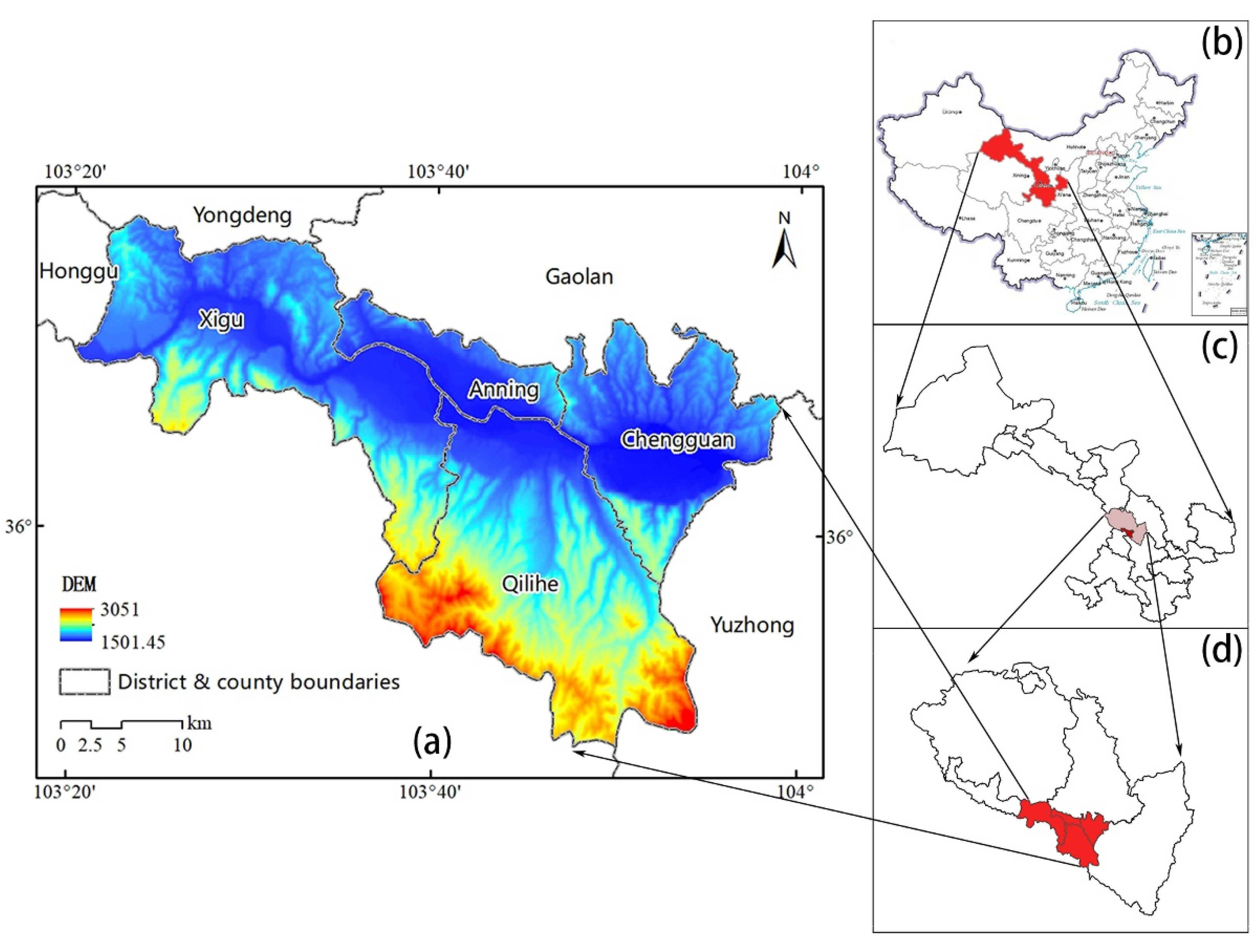
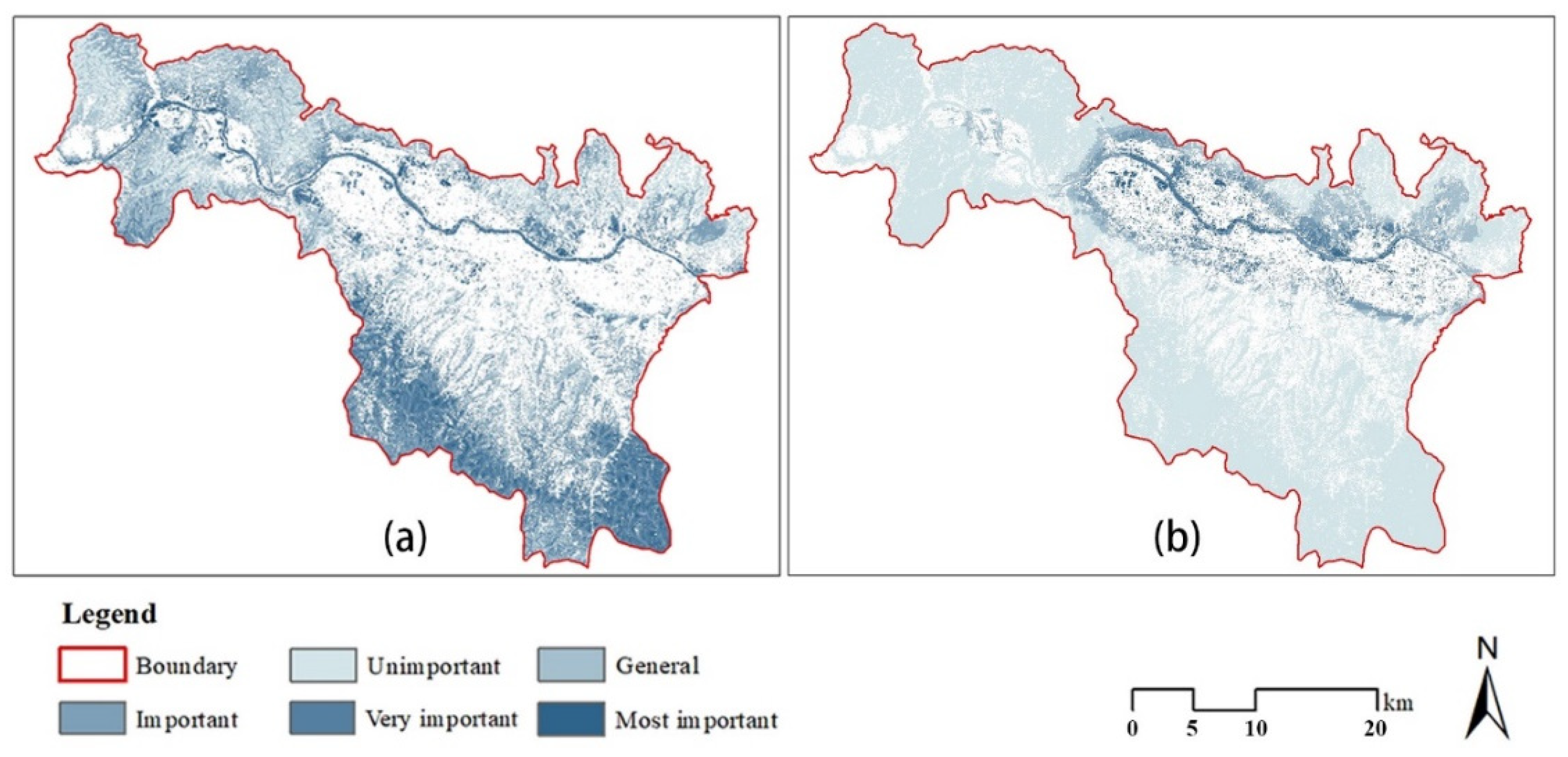
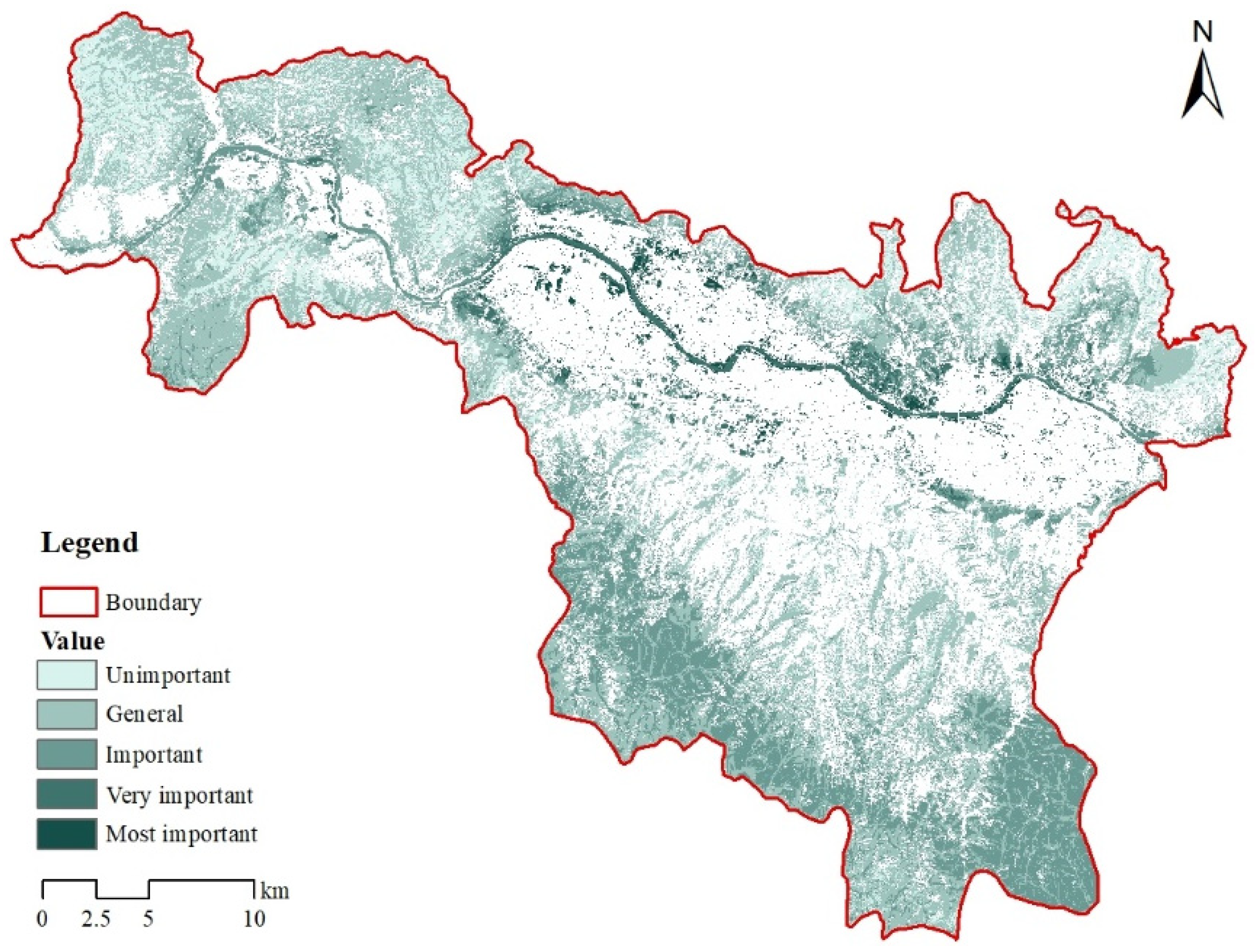
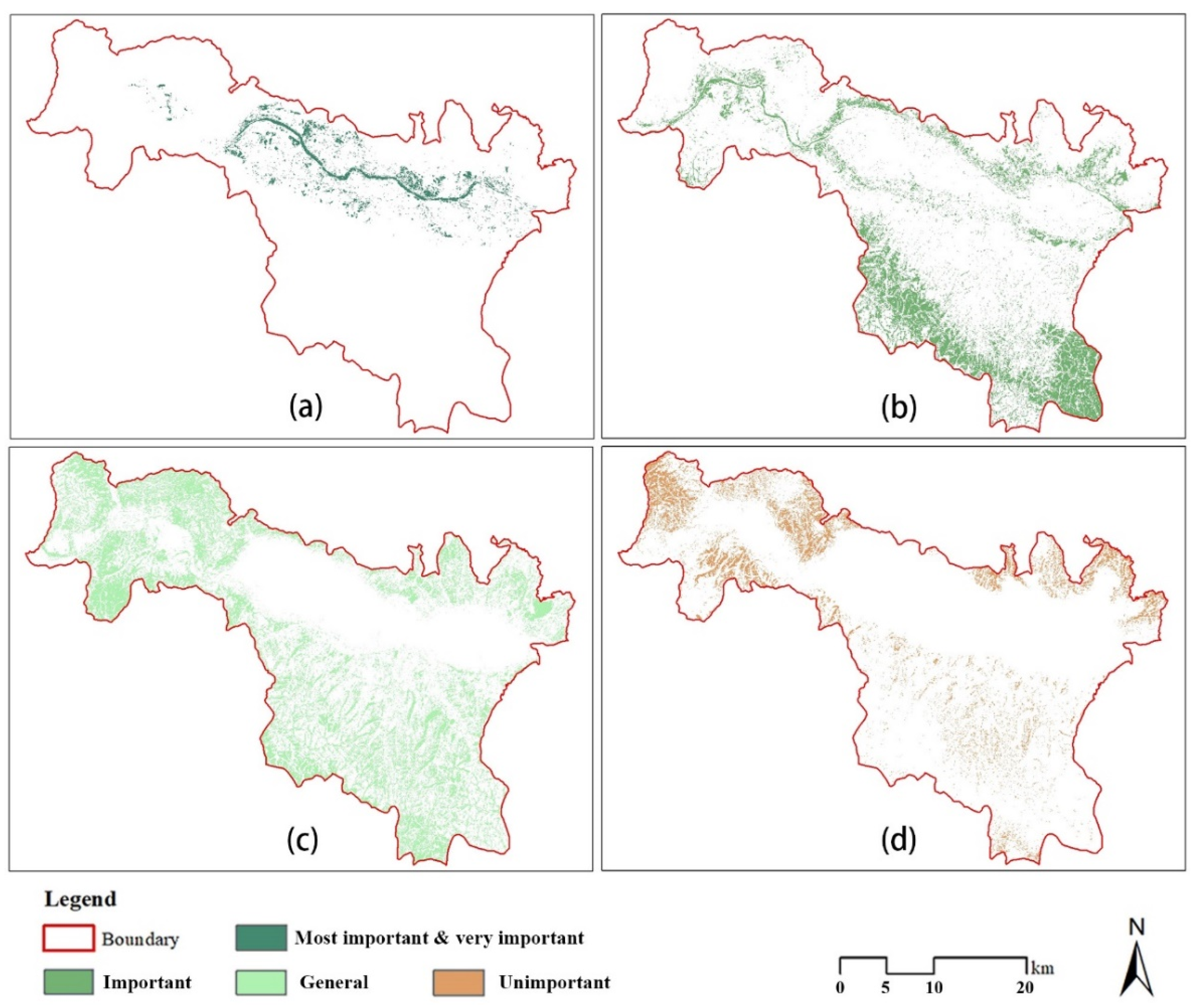

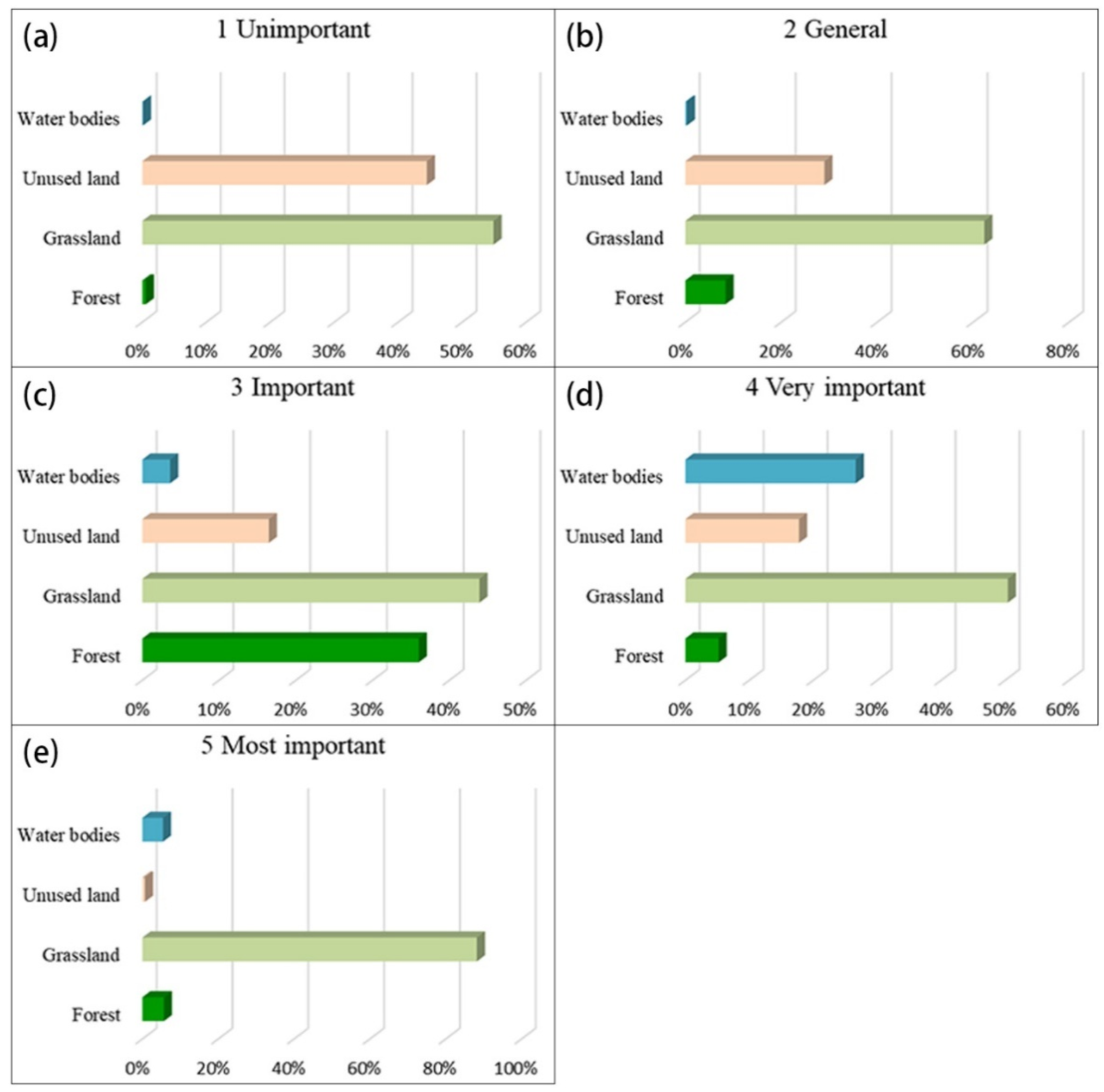
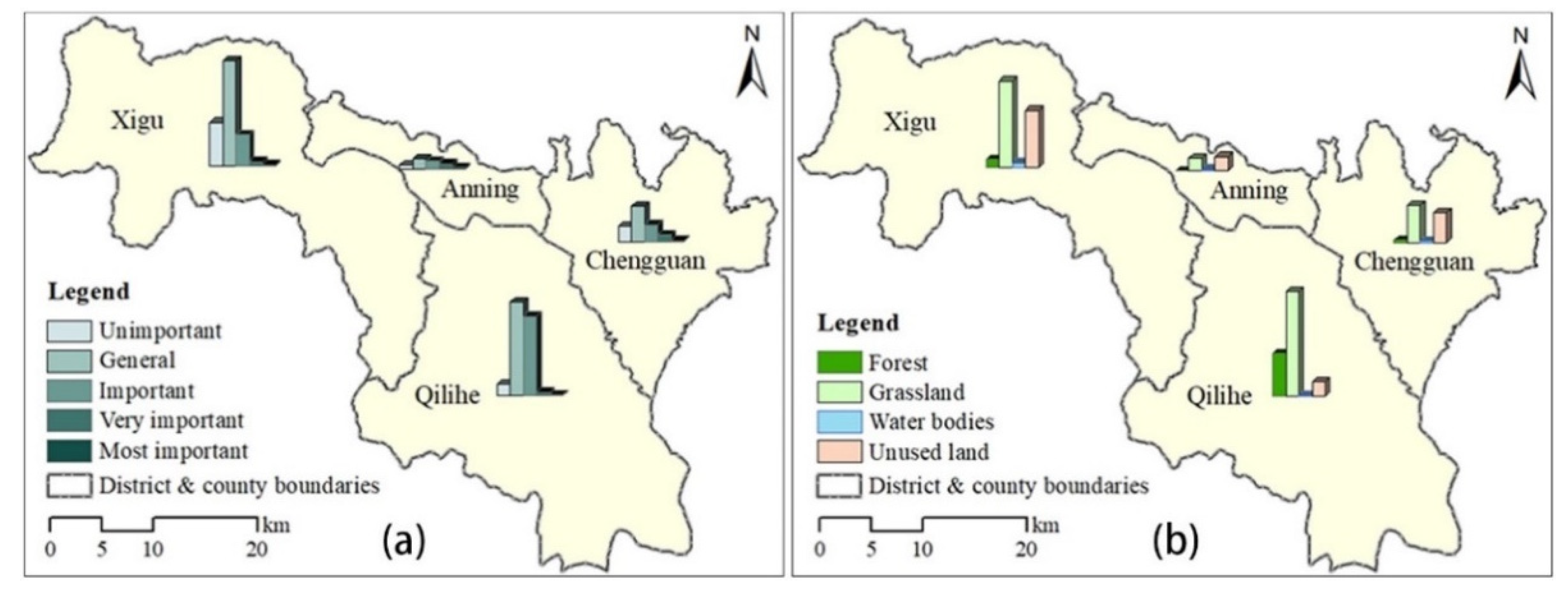
| Evaluation Factors | Distance from Water Area (km) | Slope (%) | FVC (%) | Importance | Value |
|---|---|---|---|---|---|
| Weight | 0.35 | 0.18 | 0.47 | ||
| Classification | 0–0.5 | <5 | 0.5–1 | Most important | 5 |
| 0.5–1 | 5–10 | 0.4–0.5 | Very important | 4 | |
| 1–1.5 | 10–15 | 0.3–0.4 | Important | 3 | |
| 1.5–2 | 15–20 | 0.2–0.3 | Generally important | 2 | |
| >2 | >20 | 0–0.2 | Unimportant | 1 |
| Importance Level of Ecological Patches | Coverage Area (km2) | Proportion in All Ecological Land (%) | Proportion in the Study Area (%) |
|---|---|---|---|
| The most important ecological patches | 12.70 | 1.5 | 1.21 |
| The very important ecological patches | 36.82 | 4.36 | 3.52 |
| The important ecological patches | 154.7 | 18.31 | 14.8 |
| The generally important ecological patches | 401.7 | 47.52 | 38.4 |
| The unimportant ecological patches | 239.3 | 28.31 | 22.88 |
Publisher’s Note: MDPI stays neutral with regard to jurisdictional claims in published maps and institutional affiliations. |
© 2021 by the authors. Licensee MDPI, Basel, Switzerland. This article is an open access article distributed under the terms and conditions of the Creative Commons Attribution (CC BY) license (https://creativecommons.org/licenses/by/4.0/).
Share and Cite
Liu, Y.; Lu, C.; Mao, J.; Pang, J.; Liu, Z.; Hou, M. Comprehensive Evaluation of the Importance of Ecological Land in Arid Hilly Cities in Northwest China: A Case Study of the Core Urban Area of Lanzhou. Land 2021, 10, 942. https://doi.org/10.3390/land10090942
Liu Y, Lu C, Mao J, Pang J, Liu Z, Hou M. Comprehensive Evaluation of the Importance of Ecological Land in Arid Hilly Cities in Northwest China: A Case Study of the Core Urban Area of Lanzhou. Land. 2021; 10(9):942. https://doi.org/10.3390/land10090942
Chicago/Turabian StyleLiu, Yiping, Chengpeng Lu, Jinhuang Mao, Jiaxing Pang, Zhiliang Liu, and Muchen Hou. 2021. "Comprehensive Evaluation of the Importance of Ecological Land in Arid Hilly Cities in Northwest China: A Case Study of the Core Urban Area of Lanzhou" Land 10, no. 9: 942. https://doi.org/10.3390/land10090942
APA StyleLiu, Y., Lu, C., Mao, J., Pang, J., Liu, Z., & Hou, M. (2021). Comprehensive Evaluation of the Importance of Ecological Land in Arid Hilly Cities in Northwest China: A Case Study of the Core Urban Area of Lanzhou. Land, 10(9), 942. https://doi.org/10.3390/land10090942






